- Introduction: Discovering a Glass Art Treasure in Downtown Tokyo
- Distinctive Features of Edo Kiriko: The Beauty of Color and Cut
- Edo Kiriko’s History: From the Edo Period to Worldwide Recognition
- Edo Kiriko Today: Popular Brands and Workshops
- The Joys of Edo Kiriko: From Souvenirs to Everyday Use
- Conclusion: Add Some Edo Kiriko Sparkle to Your Travel Memories
Introduction: Discovering a Glass Art Treasure in Downtown Tokyo
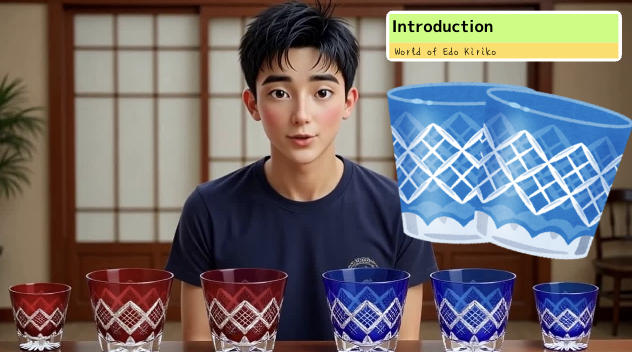
Hello everyone! Today, I’m excited to introduce a traditional Japanese craft that I believe every American visitor to Tokyo should know about.
It’s called Edo Kiriko, a dazzling style of cut glass that originated in the Edo period. Imagine intricate patterns meticulously carved into layers of brilliantly colored glass, each piece catching the light like a tiny prism.
When you stroll through Tokyo’s old neighborhoods, you may even hear the whir of artisans grinding glass by hand, reminding you of a time when craftsmanship was king. In this video, I’ll share everything you need to know about Edo Kiriko: its unique features, its history, the brands and workshops you should look out for, and creative ways to make it part of your daily life.
Think of it as adding a bit of Tokyo sparkle to your travel memories.
Distinctive Features of Edo Kiriko: The Beauty of Color and Cut

Let’s start with what makes Edo Kiriko so mesmerizing. Artisans skillfully carve geometric or nature-inspired designs onto the surface of glass, creating a raised texture that shimmers in the light.
Often, they overlay a clear base with deep red or blue glass, then cut through the colored layer to reveal the transparent glass beneath.
This process yields stark and beautiful contrasts that shift depending on how the light hits each facet. Many of the traditional designs carry a unique story.
Some reflect patterns believed to protect against misfortune, while others symbolize vitality or harmony.
Learning the meanings of these designs can enhance your appreciation for the art, as if you’re holding an entire cultural narrative in one small glass.
Edo Kiriko is also notable for the level of craftsmanship involved.
Every stage, from layering colored glass to the final polishing, relies heavily on the artisan’s skill and intuition.
After sketching guidelines, they use diamond wheels or similar tools to carve the patterns freehand. If a mistake happens partway through, the entire piece can become unusable, so it’s a high-stakes art.
Once the cuts are made, the surface is polished with wooden or felt tools to restore clarity. Despite looking delicate, many Edo Kiriko pieces are surprisingly strong, so you can actually use them in daily life without too much worry.
Edo Kiriko’s History: From the Edo Period to Worldwide Recognition
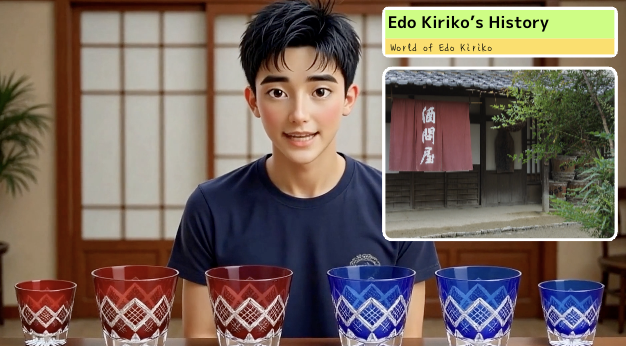
Now, let’s talk history. Edo Kiriko traces its origins to around 1834, when a glass merchant in Tokyo named Kagaya Kyubei began experimenting with etched designs on imported European glass.
At the time, Western influence was making its way into Japan through Dutch traders, and some savvy entrepreneurs saw an opportunity.
Over the following decades, Japan’s modernization in the Meiji era brought in advanced cutting and polishing techniques from Europe, which refined the quality of Edo Kiriko.
Glass artisans in Tokyo also absorbed ideas from regional Japanese glass traditions, such as the rich colors of Satsuma Kiriko from Kagoshima.
Although World War II severely disrupted production due to shortages of materials and forced factory closures, dedicated craftspeople managed to keep Edo Kiriko alive.
By the late 20th century, the craft gained official recognition as one of Tokyo’s traditional industries, fueling renewed interest and support.
Today, Edo Kiriko represents a delightful blend of old Edo-era aesthetics and global influences, with each piece capturing a little bit of Tokyo’s past and present.
Edo Kiriko Today: Popular Brands and Workshops
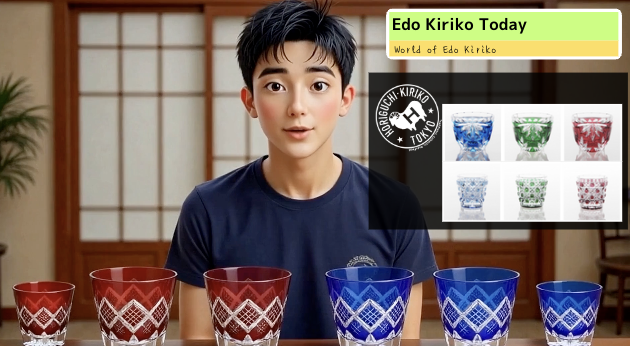
If you’re curious to see Edo Kiriko up close, there are several workshops and stores in Tokyo where you can watch artisans at work or buy your own piece of this sparkling art. Horiguchi Kiriko is one of the most iconic, led by a distinguished craftsman carrying the title “Shuuseki,” signifying the highest level of mastery.
Their pieces often blend classic Edo-era patterns with more understated designs that fit well into modern interiors. Another highlight is Hanashyo, known for its innovative patterns such as “Kome-tsunagi,” or “linked rice grains.” This studio uses only hand-polishing methods to ensure sharp edges and an unmatched brilliance. Their work has been selected for prestigious international presentations, showcasing how far Edo Kiriko has come on the world stage.
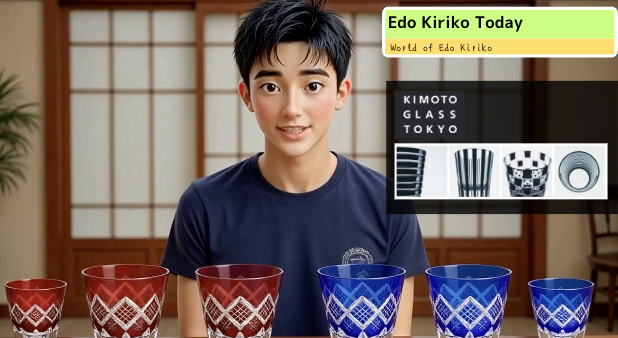
I also want to introduce Kimoto Glass, especially their KUROCO line. Kimoto Glass is a Tokyo-based studio that combines time-honored Edo Kiriko techniques with sleek modern design.
KUROCO, in particular, features minimalist cuts that accentuate bold, dark tones. These pieces stand out for their simplicity and elegance, and I can personally vouch for their durability and timeless look.
I’ve used KUROCO glassware for over a decade, and it still feels fresh and refined every time I take it out. If you’re seeking Edo Kiriko that fits seamlessly into a contemporary lifestyle—while still holding onto traditional roots—KUROCO is a fantastic choice.
Besides these individual brands, you can explore places like the Sumida Edo Kiriko Kan in Tokyo’s Sumida Ward, where multiple artisans’ works are displayed in one location.
They often screen videos of the production process and offer the chance to handle various styles of glassware. Some shops and workshops even run brief classes where you can try your hand at carving a simple pattern.
Whether you choose a big workshop or a small family-run studio, you’ll quickly appreciate the passion and finesse that go into each creation.
The Joys of Edo Kiriko: From Souvenirs to Everyday Use
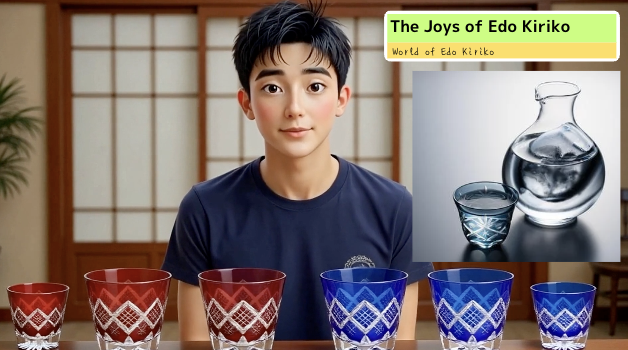
So how do you get the most out of Edo Kiriko once you decide to bring it home? While it can be tempting to treat these pieces like museum treasures, they are made to be used. Enjoying your favorite drink in a brilliantly cut glass can transform even a simple moment into something memorable.
Some people also love giving Edo Kiriko as a gift or souvenir. Because each design carries an auspicious meaning—like health, prosperity, or protection from bad luck—presenting a pair of Edo Kiriko glasses makes for a thoughtful gift.
Many of the workshops also offer different color options, letting you choose something that matches your decor or personal style.
If you prefer to display these items, consider positioning them near a window where they can catch sunlight, or place a small lamp behind them to highlight the etched patterns.
The resulting interplay of light and shadow creates a captivating effect. Some artisans are even branching out into Kiriko-inspired lighting fixtures and tableware sets, which can turn any living space into a mini art gallery. Feel free to get creative.
A small Edo Kiriko cup can double as a tiny vase, or a shallow dish might become an elegant container for candy. In the end, Edo Kiriko truly shines when you integrate it into everyday life in a way that resonates with your personal taste.
Conclusion: Add Some Edo Kiriko Sparkle to Your Travel Memories
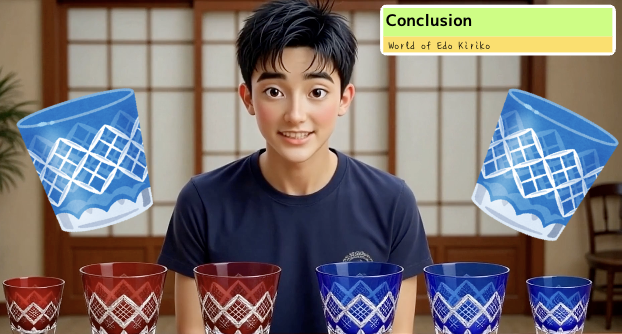
We’ve spent the last twenty minutes or so exploring the shimmering world of Edo Kiriko. I hope you’ve enjoyed learning about this deeply rooted yet ever-evolving form of glass art. Each piece offers a window into Tokyo’s past and a testament to its artisan spirit.
Whenever you visit neighborhoods like Asakusa, Nihonbashi, or Sumida, take time to discover these workshops.
Touch the glass, examine the cuts, and think about the dedication behind each line. If you do decide to bring a piece home—be it from Horiguchi Kiriko, Hanashyo, or the KUROCO line from Kimoto Glass—you’ll be carrying a slice of Tokyo tradition right into your daily life.
Thank you for watching, and may your own journey sparkle just as brightly as Edo Kiriko!


